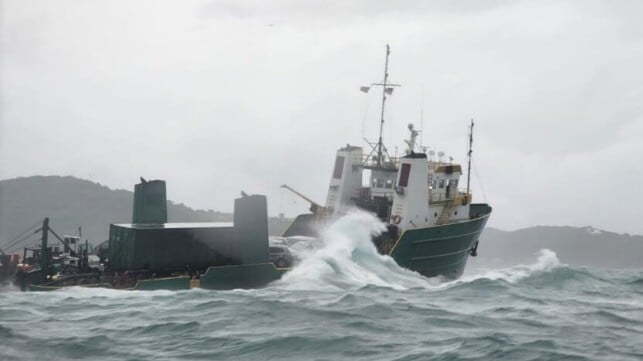NTSB: Parted Anchor Chain and Improper Charting Led to Vessel Loss

An inadequate anchoring operation and failure to use available charts to identify depths and a charted rock led to the loss of a cargo vessel operating in the U.S. Virgin Islands reports the National Transportation Safety Board (NTSB). The bureau issued a report highlighting a series of errors during a storm that contributed to the total constructive loss of a small cargo vessel valued at $1.5 million and a heroic action by the U.S. Coast Guard to rescue 12 people from the stranded ship.
The cargo vessel Bonnie G (780 gross tons), built in 1981, stranded on the rocks off St. Thomas in the USVI on October 4, 2023, while it was waiting out bad weather which had prevented it from docking. The ship, which had been built as an offshore supply vessel for the Gulf of Mexico oil platforms, had been converted in 2020 to cargo operations. It was sailing between San Juan, St. Thomas, St. Croix, and other local islands in the Caribbean. It was 172 feet long and registered in Vanuatu.
The cargo ship loaded in St. Croix with six passenger vehicles, an industrial truck, a trailer, scissor lift, a refrigerated container with fruits and vegetables, and other cargo ranging from beer and whiskey to medical supplies and books. It departed St. Croix with 12 people aboard at 1550 for an anticipated 7.5-hour trip to St. Thomas.
The captain told NTSB that he was aware that there was a tropical storm to the north and consulted weather reports. There was a small craft advisory and a forecast of winds 10-15 knots with gusts to 25 knots and seas up to 9 feet. The captain determined the weather was “acceptable” and decided to get underway.
When they reached Red Point on St. Thomas around midnight, the weather had deteriorated and the port advised that a barge had broken away from its mooring and was partially blocking the dock for the Bonnie G. The captain decided to anchor to wait out the storm. He told the investigators he through the area was maybe 23 to 26 feet deep, so he ordered 135 feet of chain and set a watch and alarms before leaving the bridge.
An able-bodied seafarer was on watch and at 0120 the captain returned to bridge after hearing a nose. Saying that everything appeared “normal” the captain left the bridge, but at 0300 the AB alerted the captain the vessel was drifting. The AB was ordered to heave the anchor as the captain planned to get underway, but the AB reported back the anchor chain had parted. Minutes later moving at 0.8 knots the Bonnie G ran aground on a rock.
Unable to get the vessel free, the captain told the USCG that they needed to abandon ship. The USCG crew reported conditions were a sustained 24 knot wind, gusting to 33 knots, and seas 4 to 8 feet with less than 1 mile of visibility. They were able to recover the people from the Bonnie G.
The Bonnie G remained on the rocks and was later salvaged by DonJon-SMIT. It had flooded and had extensive damage leading to it being declared a loss.
NTSB cites a series of errors. They believe the captain made an erroneous assessment of the water depth which was actually 68 feet where he attempted to anchor not the 23 to 26 he assumed. He did not check charts available in the vessel and “an inadequate scope of chain” was deployed when anchoring. NTSB believes that led to the anchor chain parting.
“When anchoring a vessel, a length of anchor chain that is five to seven times the water depth (scope, or ratio of anchor chain to water depth) should be used; even more anchor chain should be used in adverse weather,” the report said.
Getting underway, NTSB reports the captain also did not use the available onboard navigational chart to identify a rock nearby, and when maneuvering after the anchor chain failed, he inadvertently steered directly onto the rock and grounded the vessel. As a result, the hull was breached just forward of the engine room.
The chief engineer told NTSB he was in the engine room and saw the flooding and became fearful. NTSB reports the forward watertight door in the engine room of the Bonnie G was open and not secured before the crew abandoned the vessel. Investigators determined that had the watertight door been shut as required, it is likely that progressive flooding of the engine room and aft spaces would not have occurred, limiting vessel damage.
NTSB concludes the report warning when anchoring, mariners should review navigational charts and other sources to become familiar with nearby hazards. The heavy weather conditions increased the risk and the potential of having to get underway on short notice.
